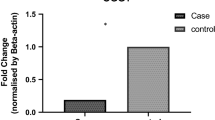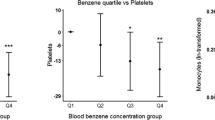Abstract
Background
1, 3-Butadiene is a famous industrial compound which occurs in gasoline and diesel exhaust and in cigarette smoke. Based on little evidence of carcinogenicity in laboratory animals and humans, it was classified as a probable carcinogen. The potential of exposure to gasoline and diesel exhaust containing these chemical compounds is very considerable in urban areas. According to studies, in estimation of workers’ chronic exposure with biological samples, analysis of the concentration of related hemoglobin adducts seems to give the most valid estimation of exposure.
Methods
This study designed to determine the level of chronic exposure in gas station workers and traffic policemen during routine work shift, by an appropriate biological marker. In this regards, 25 gas station workers, 25 policemen engaged in traffic control, and 25 occupationally non-exposed persons were studied. Blood samples were obtained after the work shift from each person. The level of selected hemoglobin adduct, 1- and 2-hydroxy-3-butenyl valine (MHBVal) was determined by using GC–MS after a modified Edman degradation and a further acetylation.
Results
There were significant differences among the mean concentrations of MHBVal in blood samples of gas station workers, policemen and occupationally non-exposed persons. The mean airborne levels of 1, 3-Butadiene over 60 days, differed significantly among different studied groups (ANOVA: p < 0.05 and Kruskal-Wallis test: p < 0.05).
Conclusion
There was a significant difference in MHBVal concentrations between job categories (p < 0.05 by ANOVA and Kruskal-Wallis test), and gas station workers and policemen were found to be probably the most exposed groups in this research.
Similar content being viewed by others
Availability of data and materials
The data will not be shared with a reason.
Abbreviations
- IARC:
-
International Agency for Research on Cancer
- BD:
-
1, 3-Butadiene
- MHBVal:
-
1- and 2-hydroxy-3-butenyl valine,
- TWA:
-
Time weight average
References
Huff J, Melnick R, Solleveld H, Haseman J, Powers M, Miller R. Multiple organ carcinogenicity of 1, 3-butadiene in B6C3F1 mice after 60 weeks of inhalation exposure. Science. 1985;227(4686):548–9.
Program NT. NTP toxicology and carcinogenesis studies of 1, 3-butadiene (CAS No. 106–99-0) in B6C3F1 mice (inhalation studies). National Toxicology Program technical report series. 1993;434:1.
Cancer, I.A.f.R.o., Some chemicals that cause tumours of the kidney or urinary bladder in rodents and some other substances. IARC monographs on the evaluation of carcinogenic risks to humans, 1999;73:131–82.
Sielken RL Jr, Valdez-Flores C, Gargas ML, Kirman CR, Teta MJ, Delzell E. Cancer risk assessment for 1, 3-butadiene: dose–response modeling from an epidemiological perspective. Chem Biol Interact. 2007;166(1–3):140–9.
Phillimore P, Reading R. A rural advantage? Urban—rural health differences in northern England. J Public Health. 1992;14(3):290–9.
Polednak AP. Re:“relation between population density and cancer incidence, ILLINOIS, 1986–1990”. Am J Epidemiol. 1994;139(7):741–2.
Filippini T, Hatch EE, Rothman KJ, Heck JE, Park AS, Crippa A, Orsini N, Vinceti M. Association between outdoor air pollution and childhood leukemia: a systematic review and dose–response meta-analysis. Environ Health Perspect. 2019;127(4):046002.
Hakkola M, Saarinen L, Pekari K. Exposure to gasoline vapour during offloading of tankers and railway wagons and biological multicomponent monitoring. J Occup Health. 2001;43(5):287–90.
Scibetta L, Fustinoni S, Campo L, Valla C, Costamagna P, Consonni D, Foà V. Urinary MTBE as biological marker of exposure to traffic exhaust fumes. G Ital Med Lav Ergon. 2005;27(3):315–7.
Urban M, Gilch G, Schepers G, Miert E, Scherer G. Determination of the major mercapturic acids of 1, 3-butadiene in human and rat urine using liquid chromatography with tandem mass spectrometry. J Chromatogr B. 2003;796(1):131–40.
Eckert E, Schmid K, Schaller B, Hiddemann-Koca K, Drexler H, Göen T. Mercapturic acids as metabolites of alkylating substances in urine samples of German inhabitants. Int J Hyg Environ Health. 2011;214(3):196–204.
Carrieri M, Bartolucci GB, Paci E, Sacco P, Pigini D, Zaratin L, Cottica D, Scapellato ML, Tranfo G. Validation of a radial diffusive sampler for measuring occupational exposure to 1, 3-butadiene. J Chromatogr A. 2014;1353:114–20.
Sakurai K, Miyake Y, Amagai T. Reliable passive-sampling method for determining outdoor 1, 3-butadiene concentrations in air. Atmos Environ. 2013;80:198–203.
Li W, Chen J, Jiang D, Xin C, Cao Y, Li F. Sensitive determination of two major mercapturic acid metabolites of 1, 3-butadiene in human urine based on the isotope dilution ultrahigh performance liquid chromatography-tandem mass spectrometry. Anal Methods. 2015;7(11):4691–8.
Törnqvist M, Mowrer J, Jensen S, Ehrenberg L. Monitoring of environmental cancer initiators through hemoglobin adducts by a modified Edman degradation method. Anal Biochem. 1986;154(1):255–66.
Pérez HL, Lähdetie J, Landin HH, Kilpeläinen I, Koivisto P, Peltonen K, Osterman-Golkar S. Haemoglobin adducts of epoxybutanediol from exposure to 1, 3-butadiene or butadiene epoxides. Chem Biol Interact. 1997;105(3):181–98.
Schenk L, Hansson SO, Rudén C, Gilek M. Occupational exposure limits: a comparative study. Regul Toxicol Pharmacol. 2008;50(2):261–70.
Barsan, M.E., NIOSH pocket guide to chemical hazards. 2007.
Sapkota A, Halden RU, Dominici F, Groopman JD, Buckley TJ. Urinary biomarkers of 1, 3-butadiene in environmental settings using liquid chromatography isotope dilution tandem mass spectrometry. Chem Biol Interact. 2006;160(1):70–9.
Fustinoni S, Perbellini L, Soleo L, Manno M, Foà V. Biological monitoring in occupational exposure to low levels of 1, 3-butadiene. Toxicol Lett. 2004;149(1–3):353–60.
Bond JA, Medinsky MA. Insights into the toxicokinetics and toxicodynamics of 1, 3-butadiene. Chem Biol Interact. 2001;135:599–614.
Albertini R, et al. Biomarkers in Czech workers exposed to 1, 3-butadiene: a transitional epidemiologic study. Research Report (Health Effects Institute). 2003;(116):1.
Boogaard PJ, van Sittert NJ, Megens HJ. Urinary metabolites and haemoglobin adducts as biomarkers of exposure to 1, 3-butadiene: a basis for 1, 3-butadiene cancer risk assessment. Chem Biol Interact. 2001;135:695–701.
Acknowledgments
This study was supported by National Institute for Medical Research Development (Grant No. 965455) and Iranian National Science Foundation (INSF) under Grant 96010139. Hereby, the cooperation of the University and also the Institute for Environmental Research (IER) is highly appreciated.
Funding
This study was supported by National Institute for Medical Research Development (Grant No. 965455) and Iranian National Science Foundation (INSF) under Grant 96010139. Hereby, the cooperation of the University and also the Institute for Environmental Research (IER) is highly appreciated.
Author information
Authors and Affiliations
Contributions
RA and NR participated in the design of the study. RA did the analyses and FI interpreted the analyzed results. NR was the main investigator, supervised the work, drafted and revised the paper critically for important intellectual content and compiled the work in accordance with journal format. All authors have read and approved the final manuscript.
Corresponding author
Ethics declarations
Ethics approval and consent to participate
The research protocol was approved by Ethics Committee of Tehran University of Medical Sciences (IR.TUMS.SPH.REC.1396.2335).
Consent for publication
Not applicable.
Competing interests
The authors declare that they have no competing interests.
Additional information
Publisher’s note
Springer Nature remains neutral with regard to jurisdictional claims in published maps and institutional affiliations.
Rights and permissions
About this article
Cite this article
Ahmadkhaniha, R., Izadpanah, F. & Rastkari, N. Hemoglobin adducts as an important marker of chronic exposure to low concentration of 1, 3-butadiene. J Environ Health Sci Engineer 19, 1607–1611 (2021). https://doi.org/10.1007/s40201-021-00716-8
Received:
Accepted:
Published:
Issue Date:
DOI: https://doi.org/10.1007/s40201-021-00716-8




